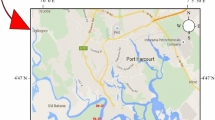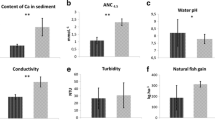Abstract
An exploratory study was carried out at 22 sampling stations along the Langat River, Selangor in order to investigate on the vitality of cation exchange capacity (CEC) in sediment (0–5 cm). Parameters such as pH, Eh, salinity, and electrical conductivity (EC) were determined. The CEC in sediment has been calculated by the determination of Ca2+, Na+, Mg2+, and K+ using the flame atomic absorption spectrophotometer, while the organic matter content in sediment was ascertained using the loss on ignition method. The characteristic of the sediment shows that pH (3.09–7.46), salinity (0.02–10.71 ppt), EC (3.39–517 μS/cm) and Eh (−16.20–253.10 mV) were substantially high in variation. This study also revealed that exchangeable Ca2+ and Mg2+ were controlled by organic matter contents, while exchangeable Na+ and K+ were influenced by salinity. Salinity was observed to play a major part in controlling all the exchangeable cations, as it gives strong significant correlations with Na+, K+, Mg2+, CEC, and organic matter at p < 0.01. The presence of seawater, clay mineralogy, and organic matter proves that it does play an important role in determining the CEC and soon relates to the pollution magnitude in the sediment.





Similar content being viewed by others
References
Alkarkhi FM, Ismail N, Ahmed A, Mat Easa A (2009) Analysis of heavy for metals concentrations in sediments of selected estuaries of Malaysia—a statistical assessment. Environ Monit Assess 153:179–185
Alloway BJ (1990) Soil processes and the behavior metals. In: Alloway BJ (ed) Heavy metals in soils. Wiley, Glasgow
American Public Health Association (2005) Standard methods for the examination of water and wastewater, 21st edn. American Water Works Association, Water Environment Federation, Washington
Apello CAJ, Postma D (2005) Geochemistry, groundwater and pollution, 2nd edn. CRC/Balkema, Roterdam
Aris AZ, Abdullah MH, Praveena SM, Yusoff MK, Juahir H (2010) Extenuation of saline solutes in shallow aquifer of a small tropical island: a case study of Manukan Island, North Borneo. Environment Asia 3:84–92
Aris AZ, Praveena SM, Abdullah MH, Radojevic M (2012) Statistical approaches and hydrochemical modelling of groundwater system in a small tropical island. J Hydroinform 14(1):206–220
Ashraf MA, Maah MJ, Yusoff I, Wajid A, Mahmood K (2011) Sand mining effects, causes and concerns: a case study from Bestari Jaya, Selangor, Peninsular Malaysia. Sci Res Essays 6(6):1216–1231
Bierman P, Lewis M, Ostendorf B, Tanner J (2011) A review of methods for analysing spatial and temporal patterns in coastal water quality. Ecol Indicat 11:103–114
Bohn HL, Mc Neal BL, O’Connor GA (1979) Soil Chemistry. Wiley, New York
Camberato JJ (2001) Cation exchange capacity—everything you want to know and much more. First printed in South Carolina Turfgrass Foundation News, October–December, 2001. http://ebookbrowse.com/cation-exchange-capacity-pdf-d19788599. Accessed 8 May 2011
DeLaune RD, Reddy KR (2005) Redox Potential. Elsevier Ltd. http://wetlands.ifas.ufl.edu/publications/PDF-articles/Delaune%20and%20Reddy.pdf. Accessed 11 August 2011
DID (2010) Geological map of Langat River Basin. Department of Irrigation, Malaysia. Volume 1: executive summary and main report.
Dube A, Zbytniewski R, Kowalkowski T, Cukrowska E, Buszewski B (2001) Adsorption and migration of heavy metals in soil. Pol J Environ Stud 10(1):1–10
Essington ME (2004) Soil and water chemistry an integrative approach. CRC, Boca Raton
Hepper EN, Buschiazzo DE, Hevia GG, Urioste A, Antón L (2006) Clay mineralogy, cation exchange capacity and specific surface area of loess soils with different volcanic ash contents. Geoderma 135:216–223
Ismail A, Safahieh A (2005) Copper and zinc in intertidal surface sediment Telescopium telescopium from Lukut River Malaysia. Coast Mar Sci 29:111–115
Juahir H, Md Zain S, Aris AZ, Yusoff MK, Mokhtar MB (2010) Spatial assessment of Langat River water quality using chemometrics. J Environ Monit 12:287–205
Lax A, Roig A, Costa F (1986) A method for determining the cation-exchange capacity of organic materials. Plant Soil 94(3):349–355
Lim P-E, Kiu M-Y (1995) Determination and speciation of heavy metals in sediments of the Juru River, Penang, Malaysia. Environ Monit Assess 35:85–95
Lin J-G, Chen S-Y (1998) The relationship between adsorption of heavy metal and organic matter in river sediments. Environ Int 24(3):345–352
Luoma SN, Bryan GW (1981) A statistical assessment of the form of trace metals in oxidized estuarine sediments employing chemical extractants. Sci Total Environ 17:165–196
McLean JE, Bledsoe BE (1992) Behaviour of metals in soils. Groundwater Issue. United States Environmental Protection Agency (USEPA). http://www.epa.gov/tio/tsp/download/issue14.pdf. Accessed 26 January 2012.
Ololade IA, Lajide L, Amoo IA (2008) Seasonal metal distribution in Ondo coastal sediment, Nigeria. J Appl Sci Environ Manag 12(4):11–18
Orlov DS (1992) Soil chemistry. Balkema, Brookfield
Passos EA, Alves JC, Santos IS, Alves JPH, Garcia CA, Costa AS (2010) Assessment of trace metals contamination in estuarine sediments using a sequential extraction technique and principal component analysis. Microchem J 96:50–57
Praveena SM, Ahmed A, Radojevic M, Abdullah MH, Aris AZ (2007) Factor-cluster analysis and enrichment study of mangrove sediments—an example from Mengkabong, Sabah. Malays J Anal Sci 11(2):421–430
Praveena SM, Ahmed A, Radojevic M, Abdullah MH, Aris AZ (2008) Multivariate and geoaccumulation index evaluation in mangrove surface sediment of Mengkabong Lagoon, Sabah. Bull Environ Contam Toxicol 81:52–56
Praveena SM, Aris AZ, Radojevic M (2010) Heavy metals dynamics and source in intertidal mangrove sediment of Sabah, Borneo Island. Environ Asia 3(special issue):79–83
Radojevic M, Bashkin VN (2007) Practical environment analysis. The Royal Society of Chemistry/RSC, Cambridge
Sarmani S (1989) The determination of heavy metals in water, suspended materials and sediments from Langat River, Malaysia. Hydrobiologia 176(177):233–238
Sastre J, Raure G, Vidal M (2006) Effects of the cationic composition of sorption solution on the quantification of sorption–desorption parameters of heavy metals in soils. Environ Pollut 140:322–339
Soil Chemistry (2011) Section 9—oxidation reduction. http://lawr.ucdavis.edu/classes/ssc102/Section9.pdf. Accessed 16 August 2011
Tan KH (1993) Principles of soil chemistry, 2nd edn. Marcel Dekker, Athens, pp 231–233
Tengku Ismail TH, Aris AZ, Somasundram S (2011) Potential removal of Pb, Cu and Zn by Phylidrum lanuginosum in aquatic environment. Fresenius Environ Bull 20(5A):1262–1269
Turf Revolution (2011) Cation exchange capacity (CEC). http://209.213.232.153/TR/articles/cationexchangecapacity.pdf. Accessed 8th May 2011
Whitlatch RB, Johnson RG (1974) Methods for staining organic matter in marine sediments. J Sediment Res 44(4):1310–1312
Acknowledgments
The authors would like thank Mr Fahmi, Mr Isahak, Mr Kamran, Mr Hazzeman and the Lab members for their encouragements, wise ideas and also for assisting with the sampling campaign. The authors also gratefully acknowledge the Research University Grant Scheme (RUGS) project number 03-01-10-0890RU Vot 91895 and The Academy of Science for the developing World (TWAS) research grant agreement (GRA) number 09-099 RG/EAS/AS_C-UNESCO FR:3240231216 for funding this research and to Universiti Putra Malaysia for the Graduate Research Fellowship (GRF) that was granted to the first author.
Author information
Authors and Affiliations
Corresponding author
Rights and permissions
About this article
Cite this article
Shafie, N.A., Aris, A.Z. & Puad, N.H.A. Influential factors on the levels of cation exchange capacity in sediment at Langat river. Arab J Geosci 6, 3049–3058 (2013). https://doi.org/10.1007/s12517-012-0563-0
Received:
Accepted:
Published:
Issue Date:
DOI: https://doi.org/10.1007/s12517-012-0563-0




